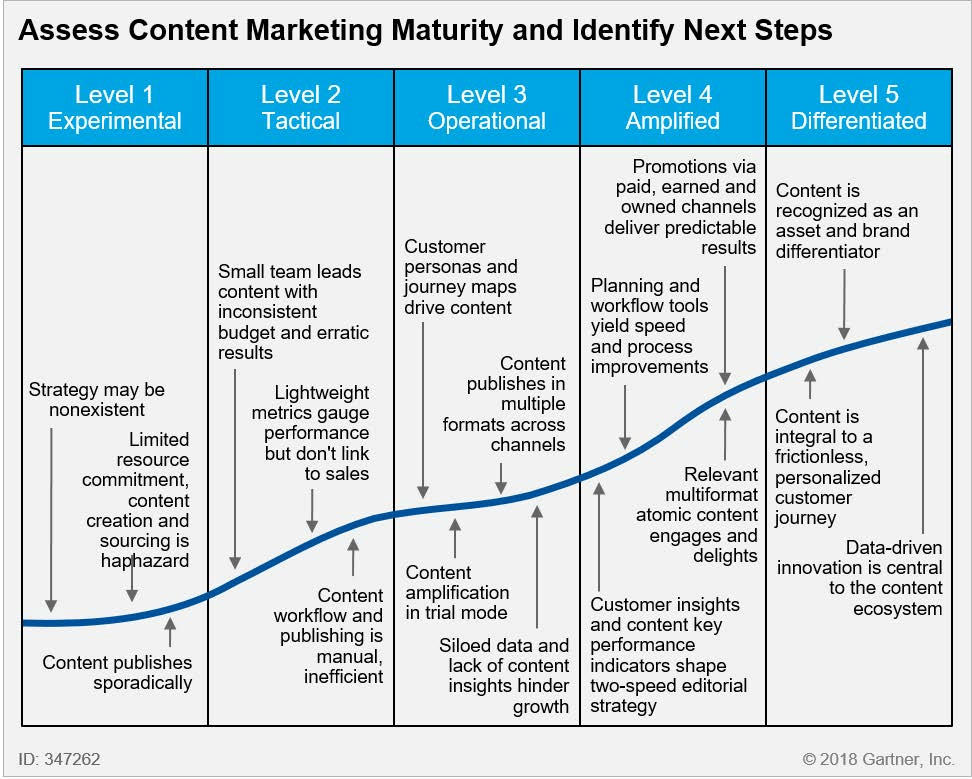When we’re onboarding a new Divvy client, one of the first things we ask in our initial discovery call is for the client to rank the maturity of their content operations on a one-to-five scale. A one represents low maturity (i.e. “we’re just getting started”), and a five means that they’re a well-oiled content machine and the content assets they produce are integral to their organization.
Most content teams fall somewhere in the middle. And as you might imagine, most teams strive to move up that maturity ladder. So, how mature is your content operation?
Using a content operations maturity model to map your content marketing proficiency can help you take stock in where you are today, and provide guidance on how to hone your content production process to get closer to process perfection (if there is such a thing…😉).
What is a content marketing maturity model?
As MarketMuse’s Camden Gaspar puts it, “A content marketing maturity model measures the extent to which content decisions are driven by established and documented processes, standards, and metrics within a marketing organization.”
Adapted to content operations by Gartner Research from the Software Engineering Institute’s “Capability Maturity Model,” this chart distills down the stages of content operations maturity into their essential components.
Image via Gartner Research
Customize this content maturity map to your company’s unique needs and put it to use to build your content operations into an efficient, data-driven machine. Follow this general outline to transform your content operations from “meh” to magnificent.
Escaping the Experimental Stage
Companies just entering their foray into content marketing often haven’t a clue about content strategy. Perhaps they’ve read articles on marketing tips and discovered content marketing there. Or maybe they’ve found that their competitors all have informative blog posts on their websites, and they’re scrambling to catch up.
Either way, they’re a lot like toddlers learning to walk. Their efforts are often sporadic, and they take a lot of falls.
Whether it’s a Google penalty for keyword stuffing (because their amateurish SEO adviser told them to scatter awkwardly worded keyword phrases throughout their content) or blatant self-promotion that adds no value to their audience, it’s a cringey time in a company’s content marketing journey.
But if that’s your company, don’t despair. Even with limited financial resources, you can revamp your strategy to produce better results and move on to the next level in your content operations’ growth.
Follow these steps to give your content more traction with your target audience.
- First, focus your content on your customers and their needs: Use your expertise to provide them with the advice they need to solve problems. When you provide them with value instead of brag sheets, they’ll share your content with their colleagues and friends.
- Next, revamp any previous content that’s awkwardly worded or doesn’t provide helpful information: Conduct a content audit to identify content that doesn’t perform up to par. Then, look for shortcomings in each piece and revise it to provide more value to your audience. Again, shoot for quality content, not exact keywords or self-promotion. Today’s AI-powered search engine algorithms “read” synonyms of suggested keywords as the keyword itself. Quality and audience value are the top priorities for modern search engines.
- Publish content regularly: While ideally, you need to shoot for 2-4 posts per week, early-stage content producers need to get on a schedule and stay on it. If your content calendar can only accommodate one post per week, that’s OK. Just make sure you publish that post.
Moving from the Tactical to the Operational Stage
At the tactical stage, you’ve grown your content operations to accommodate a small team of content producers. You’re tracking your audience engagement, and you’re attracting more followers.
However, your team’s content workflow isn’t as efficient as it could be. A lack of funds limits your publication options, so your team lacks the content automation tools to scale your outreach.
Here’s how to grow your content operations into the next stage of maturity.
Schedule a meeting with your corporate executives. During that meeting, find out what their business goals are. Explain that you’d like to align your content objectives with their own.
Be sure to show them your growing numbers. Point out that larger audiences drive more brand awareness — always a concern with any brand. And, when you show them that you plan to align your team’s goals with your corporate objectives, they’ll be more likely to award your team with a budget increase.
Use that budget increase to purchase a content marketing platform that can both automate your content publication across multiple channels and provide you with actionable content analytics to direct your next steps. With the manual steps out of the way, your team will have more time to spend on content ideation and creation.
Start to document your content strategy. Include fleshed-out customer personas and buyer’s journey maps for each target market segment. Consider putting in brand guidelines, including how you need to structure your content to achieve your corporate goals, to ensure consistency in content production.
Keep your documented strategy on your content platform to give your teams instant access if they have any questions.
Amplifying Your Reach Beyond the Operational Level
You’re putting your personas to work delivering personalized content, and you’re seeing the numbers rise. Conversions in your company’s key metrics are rolling in, and they’re looking good.
However, your creatives tend to stay in their marketing silo, so there’s little communication with other teams.
Encourage your content teams to collaborate with other teams across the enterprise. Your sales team, for instance, can provide your content production team with valuable information about objections they hear out in the field.
Similarly, content collaboration with your customer support teams will likely be a fruitful source of the feedback they hear from current customers. That way, you can provide prospects and new customers with proactive content to troubleshoot common problems should they occur.
And, reaching out to your subject matter experts will provide you with rich details about the technical expertise that undergirds your products and services. For long-form content, like ebooks and white papers, these details can be the secret sauce that can deliver more sales for your company.
Next, amplify your reach by leveraging your most productive channels to reach more prospects through paid, owned, and earned media. Increase your use of predictive analytics and automation to deliver more relevant content faster than ever before.
Identify and repurpose your best-performing content in a variety of formats to reach new audiences. Turning a great blog post into a video or a case study into an infographic helps you connect with people with different learning preferences or preferred channels.
Use audience insights to refine your strategy, putting the numbers to work to better achieve your corporate goals. Social listening, comments on your blog posts, new email subscriptions, social shares, and, of course, conversions can give you an accurate picture of how well your content is achieving your goals.
Moving on to Content Operations Mastery
Although one could certainly make the case that marketing leadership can never completely master content operations, you can get close to that goal when your content becomes one of your company’s most valuable assets. When your corporate leadership recognizes how vital your content is as a brand differentiator, you’ll know that you’re on the right track.
Giving your audience a personalized experience as they move down the sales funnel gives your content the power to set your brand apart. Using data as your content operations guidepost empowers you to deliver stellar experiences with every piece of content you produce.
Using data and proven processes to drive your marketing decisions are essential ingredients in transforming your content marketing strategy into a world-class operation.
With a content platform that accommodates content planning across your entire organization, multi-channel initiatives, and robust analytics customized to your needs, you can simplify that Herculean task considerably.
DivvyHQ has all those features — and so much more. Start your free, no-obligation trial today!

